
Food By Sailor Type Menu: 1 2 3 4 5 6 7 8 9 10 11 12 13 14 15 16 17 18 Next>>
Sailors' Food Procedures During the Golden Age of Piracy, Page 1
"Without question, equipping and preserving sufficient food and drink on long-distance voyages was intimately tied with the survival of the crew in terms of morale and nutrition and, ultimately, could determine the success or failure of the voyage." (Cheryl A. Fury, "Health and Health Care at Sea", The Social History of English Seamen, 1485-1649, p. 198)

Pirate Edward Low's Men Dining, From
Historie der Engelsche Zee-Rovers (1725)
Food is a topic of monumental importance to all those who made voyages of any significant duration. It had a direct impact on the health and well-being of a crew and was considered a crucial part of those healing from wounds and surgeries during the golden age of piracy.
There is a wealth of information about some of the elements of feeding sailors during this period, particularly what they ate and how they got it. This information exists partially because the navy was involved with the kinds and procurement of food on long voyages and they kept fairly good records. In addition, as sailors expanded the map, they also expanded their diet with some of them taking notes on what they consumed. However, actual preparation and eating of food were apparently considered so mundane that seamen barely mention them in their accounts. Nor are period cookbooks necessarily a reliable guide to food preparation and consumption by sailors since they were written primarily for the upper classes in England. As nautical food researcher Grace Tsai notes, "Cookbooks were often made by and for the elite, because most people couldn’t even read and write.”1 There is some
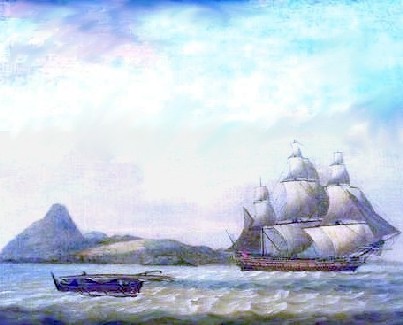
Artist: Thomas Luny - East Indiaman Hindostan, (1792)
educated discussion about how many sailors were able to read or write (the two skills were taught separately)2, but the recipes found in a cookbook belie their usefulness at sea, where fresh foods were rarely available on ships making long voyages.
This is the sixth of a series of articles which look at the food consumed by English sailors during the golden age of piracy (1690-1725), broadly dividing them by ship type: navy, merchant, privateer, select buccaneers, and pirate. The first article examines how food was used by the body and looked at the perception of healthiness of food provided to sailors. The second article discusses the many ways sailors obtained food while traveling. The third article is a continuation of ideas about obtaining food while under sail, focusing on several formal and informal 'provisioning stations' which were used by sailors. The fourth article examines how food was organized shipboard, looking at the navy's system (which impacted all other English vessels) and the various officers involved in getting, stowing, retreiving, accounting for and preparing food. The fifth article looks at how food was prepared and eaten shipboard. This article discusses the food found in the various sailor's accounts, giving and overview of foods eaten at sea and in port.
1 Tyler Allen, "Dining on the high seas", Spirit Magazine, Texas A&M Foundation Website, gathered 9/4/19; 2 See Ed Fox, Piratical Schemes and Contracts, Thesis, 2013, pp. 90-101
Foods From Sailor's Accounts During the Golden Age of Piracy
This is a series of articles
discussing the foods found in sailors accounts from the golden age of piracy (defined here as 1690-1725) along with some accounts in the thirty or so years preceding it. It presents articles for several food groups which roughly follow general
categories in use today: fruits, vegetables, grains, proteins (including meats, seafood and beans
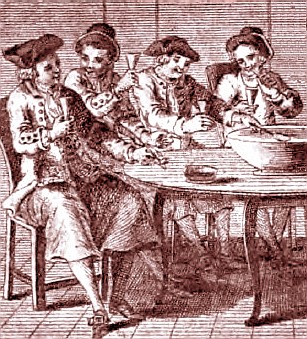
The British Sailor's Loyal Toast (1738)
and pulses (which can also be classed as vegetables), eggs & dairy, seeds and nuts) and a catch-all 'other' group which includes spices, sweets and other things that don't find handily into the previous categories.
Each of these categories are
Each category begins with a bit of data-driven information about the type of food under discussion. This is primarily of interest for reference rather than as an indicator of the popularity of foods among these visitors. Sailors' accounts frequently mention foods available at places where their ship stopped without actually stating that they ate these foods. This is likely that they list foods they found in the ports where they stopped to tell those who followed what they could expect to find; one of the reasons sailors accounts were published was to serve as a reference for those who followed them. However, some conclusions can be drawn for the popularity of each item in a category compared to the popularity of other items in the samecategory.
Following the overview, individual foods described by sailors are discussed in further detail. For each, the approximate area where it was found and the types of sailors who mention it are indicated. Because this articles focuses on sailors, the areas are based on where they were sailing: European Waters, (west of Gibralter), Mediterranean Sea Countries (east of Gibralter), West Africa (and nearby islands), East Africa (and nearby islands), East Indies (and the Orient), Central America & Caribbean, South America and North America. Where possible, a sailors description of each food is used. Where not, other period descriptions have been sought. Failing that, modern descriptions are used when needed for clarity.
Sea Victuals on Voyages During the Golden Age of Piracy
While there are a variety of interesting local, fresh foods found in this article, these things would only
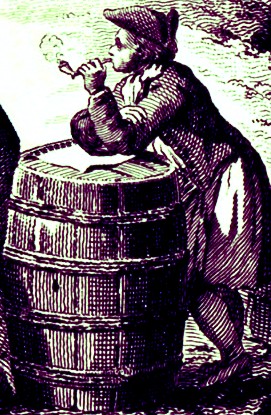
Artist: William Faden (1777)
be available to the sailors until they rotted. The food at sea on long voyages in English ships had to be able to survive for more than a few weeks. Looking at each of the five different types of sailors considered here, one might think their diets at sea were as different as the behaviors. Yet, with the exception of naval officers and sick men, nearly all sailors at sea for an extended period had similar diets. Even the officers and sick men were likely to be on this diet after their ship had been on the water for several weeks. This has a great deal to do with the inability to refrigerate foods or gather fresh victuals. Once a ship was a week or two away from land and the fresh foods had been consumed or rotted, the sailor's diet was limited to:
Dried Foods, such as raisins, beans, peas, maize, rice, flour, oatmeal, pasta and spices.
Preserved Foods, such as those salted or kept in brine (often called 'pickle') including fish, pork, beef, ruminants (particularly goats caught or purchased in foreign ports), and some vegetables.
Long-Lasting Foods, which were somewhat resistant to decay if the ingredients were properly selected, prepared, packed and stowed, including biscuit (very thoroughly-baked hard bread), oil, butter and cheese.
Live food sources which could be caught, such as fish, sea birds and turtles, as well as live animals kept penned or stabled shipboard until slaughtered.
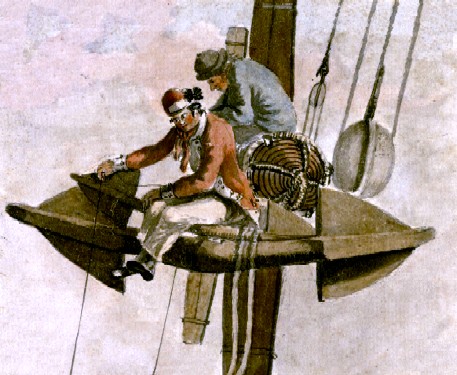
Artist: Gabriel Bray - A marine and sailor fishing off an anchor (1775)
The last category sounds like the most appealing source of food. Ship's surgeon John Fryer on the East India Company vessel Unity, said that while at sea in 1673, "Our Men at length tired with salt Provisions, [and] began to be studious for fresh; Necessity having taught them an Invention, by counterfeiting those formerly mentioned Flying-fish, with a white Rag stuffed to hide the Hook, and Feathers pricked in instead of Fins, to catch their Enemies at their own game, and so they did; providing for themselves and us too, Bonetos and Albicores"2. However fishing presented several challenges. Food caught during the voyage could not be depended upon because aquatic animals had to be available to catch and the conditions conducive to catching them. These included amenable weather, smooth ship movement and accommodating shipboard activity.
Live animals brought aboard at the beginning of a journey and penned for future slaughter made use of limited space and food on a ship. Officers were given the privilege of keeping livestock on board due to their status, which isn't to say that the regular men couldn't keep them. However, such animals had to be provided with food and water, which, along with space available, were precious while a vessel was at sea for long periods.
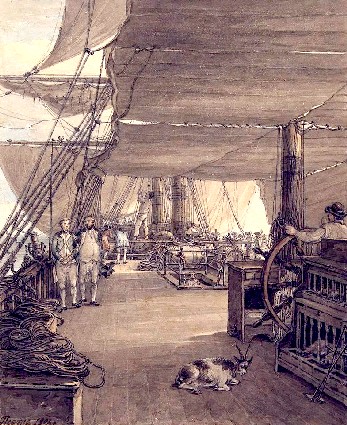
Artist: Thomas Hearne
Penned and Loose Animals Shipboard, From A Scene Aboard his
Majesty's
Ship Deal Castle in the year 1775 (1805)
This was an expense few regular sailors could manage. In addition, it is doubtful that many pirates would have been disciplined enough to feed and house animals or patient enough to wait to eat them. One exception to this were turtles primarily in South America and the Caribbean, which could be caught and turned on the backs, being kept alive for weeks by watering them.
So much of the average sailor's food would have been the limited to the preserved foods described above. Some sailors actually preferred the familiar navy diet of salt meats, fish, peas, butter, biscuit (baked bread) and cheese. Changes to it were not always welcome. Commander R. D. Merriman explains that the English navy diet changed, "for ships employed southward of latitude 39° N., the substitution of flour, raisins, and suet for beef or pork was no more popular with the seamen than was the' beverage' (country wine mixed with water) instead of beer. What they really preferred was pork and pease."2
This does not mean the sailors never wanted fresh victuals when the opportunity arose. When Woodes Rogers' privateering voyage reached Juan Fernandez Island in 1709 he noted that, "The Men who work'd ashore on our Rigging eat young Seals, which they prefer'd to our Ships Victuals [preserved foods], and said was as good as English Lamb"3. Fellow privateer George Shelvocke noted that some of his men preferred to eat cats while shipwrecked on Juan Fernandez Island because they said "their hunger found a more substantial relief from one meal of it, than from 4 or 5 of seal or fish; and to their great satisfaction, we had a small bitch which would catch almost any number they wanted in an hour or two."4
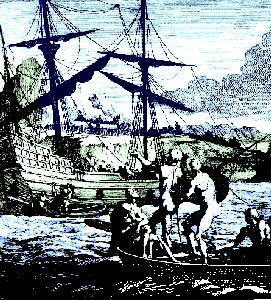
Artist: Nicholas Condy
Local Natives Trading, From Versameling der
Gedenk-Waardigste
zee en Land-Reysen na Oost en
West-Indien, Vol. 15, p 52
The variety of foods consumed typically increased when sailors could go ashore or were able to buy or trade for food from local vendors who came out to meet the ships in bum boats from land. The type of food eaten depended heavily on how much the sailors could offer in money or trade items to vendors as well as what food was available at the place where the ship had stopped. It would also naturally depend on what fresh foods were available where the ship was. This would be true for every type of sailor under study.
Many sailors found the foods overseas to be of enough interest to mention them and even comment at length on them. Such foods comprise the majority of the different foods discussed in this article because the sea diet was so limited and regular that it isn't always discussed in any detail in the accounts. However, it should be kept in mind that fresh, land-procured foods were not eaten during a long sea voyage after the first few weeks. The foods eaten by sailors at that time would be limited to those found in the list above.
Of course, just because a ship was travelling along a foreign coast, it wouldn't necessarily stop regularly to get fresh food. Anchoring near shore provided an opportunity for men to leave a ship (either with or without permission) which could result in delays or a loss in personnel when they failed to return. This was a problem for every type of ship, including pirates.
The navy is infamous for pressing men during times of war, often pulling men right off merchant ships
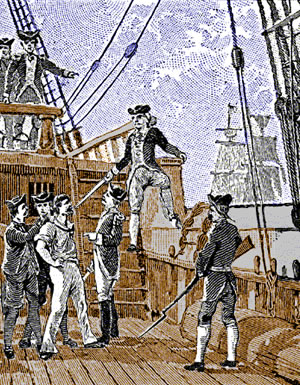
Impressment From Ship, From the Illustrated History of the
US,
By George Payn Quackenbos (1887)
arrive back home. Returning home on the merchant vessel Real Ffriendship from the Canary Islands in May of 1668, ten men from a frigate anchored off Margate, England came aboard demanding some men to man navy ships. Edward Barlow was taken, noting that "I was not suffered to go ashore in any place in half a year afterward, which was my great grief."1 The navy knew letting such sailors land could easily lead to their desertion.
Men who signed on willingly to all sorts of ships might defect when landed if they didn't like something about the voyage and they were willing to sacrifice their pay. While Nathaniel Uring's merchant vessel Hamilton was collecting logwood on the coast of Honduras, eight of his men quit him and eight more died, leaving him shorthanded.2 Four of Woodes Rogers privateers abandoned him when they stopped at the Cape of Good Hope in April of 1710.3 More than twenty of privateer George Shelvocke's men deserted at various ports where his ship made landfall,4 probably because of his leadership style. Ninety-seven of pirate William Kidd's men left him while anchored at Ile St. Marie, Madagascar in April of 1697 to join the Robert Culliford's Mocha frigate, apparently not having much faith in him as Captain. If Kidd is to be believed, this was akin to mutiny. Kidd related that "the said Deserters, sometimes in great numbers, came on board the said [Adventure] Gally and Adventure Prize, and carried away great guns, Powder, Shot, small Armes, Sailes, Anchors, Cables, Chirurgeons Chest, and what else they pleased, and threatned several times to murder" him.5 Of course, Kidd's situation was rather unique.
Many pirate crews contained forced ('pressed') men who weren't willing to sign the
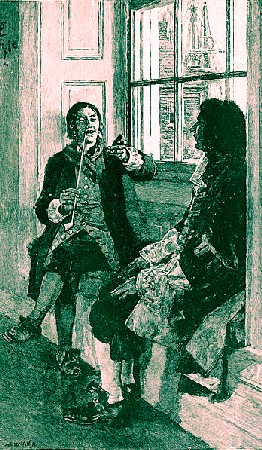
Artist: Howard Pyle
Pirates Smoking and Talking, From Howard Pyle's
Book of Pirates, p. 267 (1921)
articles and join the crew, they were willing to quit the ship when the opportunity was presented, something facilitated by being anchored near land. Fisherman Philip Ashton, pressed into pirate Edward Low's service in June of 1722, provides an example. In March of 1723, the pirates took him ashore when they were getting water where he managed to hide until the pirates "finding it in vain for them to wait any longer, they put off with their Water without me; and thus was I left" elsewhere noting that "this was the very thing I desired"6.
Even when a pirate crew wasn't pressed, there could be difficulty getting them to return while they still had money to spend in a port. While travelling with pirate captain Daniel's crew in 1705 Jean-Baptiste Labat explained how they convinced the crew to return to their ship. "In order to do this we spread a rumour in the town that an English merchantman was expected at St. Thomas, and on hearing this all the crew came aboard in the evening."7
Such concerns would make it less likely that a ship would stop for fresh food daily or even weekly unless there was an acute need. Further complicating the process of procuring fresh victuals would be the willingness of the inhabitants in populated areas to sell or trade for food, something which would affect buccaneers, privateers and pirates in particular, and might affect other English vessels depending on England's status with nationality of each individual location. In unpopulated areas (which were more likely to be encountered in the new world at this time than today), the problem would be one of finding food which could make the stop take more time and offer opportunities for sailors to abandon the vessel if they wanted to do so. As a result, the importance of sea victuals to a ship traveling along a coast cannot be overlooked.
1 John Fryer, A New Account of East India and Persia, 1698, p. 12; 2 Commander R. D. Merriman, Queen Anne's Navy, 1961, p. 250; 3 Woodes Rogers, A Cruising Voyage Round the World, 1712, p. 132; 4 George Shelvocke, A Voyage Round the World by Way of the Great South Sea, 1726, p. 251; "LETTER VIII, Islington Near London, May 29, 1727", César De Saussure, A Foreign View of England In The Reigns Of George I and George II, Madame Van Muyden, ed., 1902, p. 220; 5 Edward Barlow, Barlow's Journal of His Life at Sea In King's Ships, 1559-1703, 1934, p. 148; 6 Nathaniel Uring, The Voyages and Travels of fCapt. Uring, 1928, p. 171; 7 Rogers, p. 415; 8 Shelvocke, pp. 13,101, 242 & 250; 9 "76. Narrative of William Kidd. July 7, 1699", Privateering and Piracy in the Colonial Period - Illustrative Documents, John Franklin Jameson, ed., 1923, p. 210; 10 Philip Ashton, Ashton's Memorial Strange Adventures and Signal Deliverance, 1726. p. 43; 11 Jean-Baptiste Labat, The Memoirs of Pere Labat, 1693-1705, John Eadon ed, 1970, p. 244

